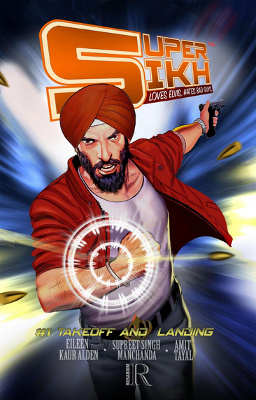 Full Title: Super Sikh #1 Takeoff and Landing
Full Title: Super Sikh #1 Takeoff and Landing
First Published: 26th April, 2017
Genre: Spy / Comic
Contributors: Eileen Kaur Alden (creator, adaptation); Supreet Singh Manchanda (creator); Amit Tayal (artist), Pradeep Sherawat (colourist), Adrian Reynolds (adaptation)
Available: Amazon.com | Amazon UK
Deep Singh is a U.N. Special Agent, but all the work is tiring him out, so he tries to take a holiday.
The first issue is an introduction to the character and central plot, where Deep goes on holiday to the USA and it doesn’t entirely work out. I saw this discussed as a superhero title, but it has more of an action spy vibe. Deep doesn’t have superhuman abilities and I didn’t get a feel that anyone else did either. He does have exceptional combat skills and some of the gadgets are more speculative.
My favourite thing about it was the family relationships. His family arrange for him to go away, and their concerns for him are clear. He has a cousin, Preeti, who works for the U.N. in research. When it comes to showing Sikhs, there’s a clear understanding of people approaching things in different ways. Deep’s older relatives wear traditional clothing. Deep’s clothing is more modern, but he has a turban and kara. Preeti has uncovered hair and no kara, outside of wearing one for a demonstration. I liked the attention to detail in how different characters expressed themselves and their faith.
Deep rarely has thoughts written out and he mainly speaks to tell jokes. This makes it difficult to really know who he is and what he thinks about what’s going on. There’s a lot of James Bond inspiration in the story, and it’d be fair to say that doesn’t focus on character much either, but that was something I didn’t like much in James Bond. I do like to get to know characters, and I don’t feel I knew much more about Deep than I did when I started reading.
The art is generally solid. It’s a realistic comic style and Deep’s facial expressions are good. I did feel some of the background characters weren’t as well rendered, particularly the black ones. I guess the artist has less experience of drawing people of some races, which may explain why there are so few background black characters. There are also some disability issues, as the art fell into using facial scarring and an eyepatch to denote someone as being evil.
There are issues when it comes to characters who aren’t Sikhs. Muslims are either terrorists or victims to be saved (when they’re women or girls). Mexicans are terrorists. Fat people are jokes. People who do bad things are crazy. There’s an attempt to subvert stereotypes when it comes to the Sikh characters, but stereotypes of anyone else are treated as the truth.
I can understand how it might have ended up here, as anyone who covers their hair or is non-white can be mistaken for being a Muslim. This means getting targeted by anti-Islamic discrimination. I get stopped by customs for a lot of random searches because they assume I’m Middle Eastern (and therefore, that I must be a Muslim). But it’s important to realise the primary issue isn’t that I’m being mistaken for a Muslim. It’s that there is prejudice against Muslims, and by extension, anyone assumed to be one. Stating that I can’t be a terrorist because I’m not a Muslim is suggesting the prejudice is grounded in fact, and that it would have been fair if they hadn’t been wrong about my identity. Like I say, I can understand why people have this reaction, but that doesn’t make it a good response. It shifts around who gets hurt rather than acknowledging the core problem. The comic very much has this type of reaction. It doesn’t tackle the assumptions that certain groups of people are terrorists and criminals. It simply distances Deep from being part of those groups.
Some of my comments could be worked out as the series continues, such as getting to know Deep a bit more. I’m rather more hesitant on the other stuff. It looks like crazy Islamic terrorist is going to be the flavour of main villain and I don’t think that’s going to be handled in a subversive way.
[A copy of this book was received from the publisher for review purposes]
 First Published: December, 2015
First Published: December, 2015 First Published: 21st August, 2017
First Published: 21st August, 2017